 You can get a good harvest of bell pepper in the conditions of regions with a rather harsh climate. In Russia, gardeners successfully grow this crop in the regions of the North-West, and in the Urals and Siberia.
You can get a good harvest of bell pepper in the conditions of regions with a rather harsh climate. In Russia, gardeners successfully grow this crop in the regions of the North-West, and in the Urals and Siberia.
The best option would be to choose early varieties, which short growing periods allow you to give the crop earlier.
Content
Description and characteristics of early pepper
Like many garden crops, sweet peppers differ in fruit ripening dates. When choosing a variety for growing, you must pay attention to this important indicator. On average, the vegetation period of peppers is 120 days, and therefore in most regions of the country, the culture is grown through seedlings.
About 80-100 days, it will be necessary to wait for fruits from early varieties and hybrids, in middle-ripening 15-30 days are added to these days, and in late peppers the first fruits can be removed only after 140 days.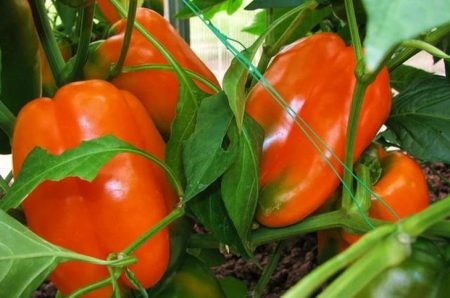
Early peppers allow you to get very good yields, even in areas of risky farming. All sorts of varieties and hybrids are presented today, the variety is large, so you can always choose peppers that will suit both the characteristics of agricultural technology and the results.
The properties
Early ripe varieties of pepper are a real find for gardeners living in the middle lane, Siberia, in the Urals. Typically, these plants differ not only by a relatively short ripening period, but also by a small height. Small, compact bushes grow well in greenhouses, in open ground, under arcs (use film or non-woven materials as a shelter).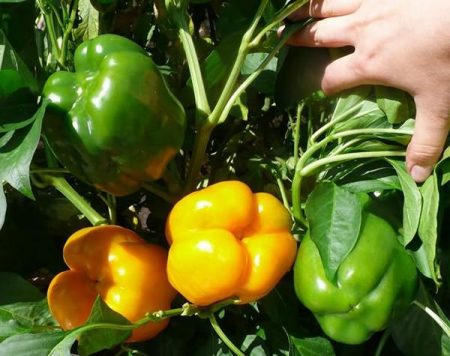
The first fruits can be removed by the beginning of July (technical maturity), and with a correctly selected variety or hybrid with a long fruiting period, peppers will grow until autumn.
As a rule, early peppers are determinant plants that have limited growth and do not require special care. They do not need the formation of a bush, and this greatly simplifies the care.
Their productivity is lower than that of indeterminate peppers, which is explained by the characteristics of the plant. But do not forget that "tall" require special agricultural technology, the formation of a bush, enhanced nutrition.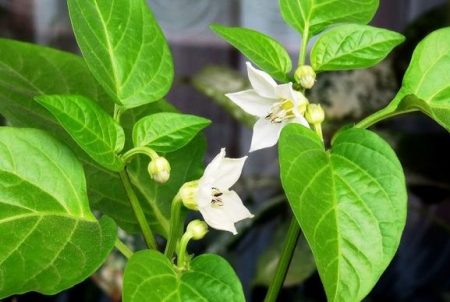
Peppers differ in the thickness of the pericarp (the walls of the fetus), and here the favorites are thick-walled varieties. Typically, such fruits produce indeterminate late varieties, but there are also early ripe ones. Thick-walled varieties and hybrids of pepper are great for stuffing, cooking lecho, and other dishes.
With early peppers, the situation is simpler and easier, while many modern hybrids are not inferior in taste to the fleshy late-ripening indices in terms of taste. Early ripe peppers are represented by varieties and hybrids, and only the gardener decides what to prefer.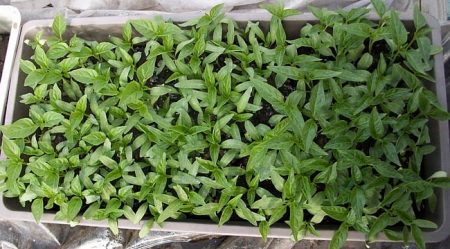
Varieties are selected and regionalized, that is, they are adapted to certain climatic conditions. This is very important for regions where there is a short and often cool summer season, where the first cold snap may come in late August or early September.
Hybrids are the result of crossbreeding, targeted breeding work. They are distinguished by higher yield indicators, resistance to many diseases, but at the same time they need the right agricultural technology.
The best varieties of early pepper
The review presents the best varieties and hybrids of culture with early ripening. They have proven themselves in a variety of conditions and, most importantly, in areas with low temperatures, limited by the number of sunny days.
Othello
Hybrid pepper with such a "literary" name will delight you with interesting fruits of a beautiful purple hue. Ripening dates - up to 109-111 days, while the hybrid gives the best results in greenhouses.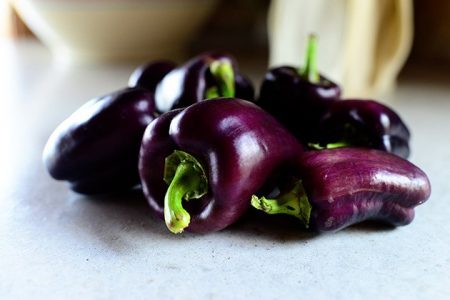
The bush is vigorous, but quite compact in size. Fruits - in the form of cones, drooping, up to 11-12 cm long. A feature of the Othello F1 hybrid is the thick walls of the pericarp (about 6-7 mm). This pepper is distinguished by excellent taste of fruits, excellent yield.
Flame
A little more than three months (about 110 days) will require waiting for the first fruits from this hybrid. Flame - a productive, early pepper with very tasty fruits.
The plant is medium-sized, with few leaves. The fruits of this hybrid are beautiful - at first yellowish, and then, when fully ripened, dark red, really resembling a flame.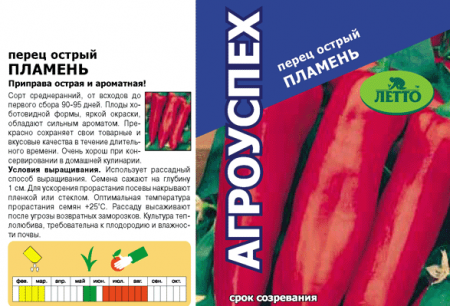
Peppers are thick-walled (up to 8 mm), large, weighing about 130-140 grams. Cone-shaped fruits have a dense glossy skin, contain a large amount of ascorbic acid.
Provide this grade with full care and then get up to 8 kg of fruit per square meter. The hybrid received excellent reviews from the gardeners of the Moscow region, the North-West.
Aeneas
One of the best orange varieties is Aeneas pepper, however, it is more likely mid-season, and not quite early. Maturing term - about 120-130 days (to the state of technical ripeness).
The bush is low, about 60 cm tall, but powerful and sprawling.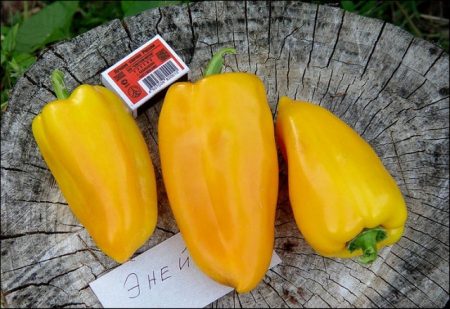
Fruits are prismatic, juicy and fleshy, with pericarp up to 10 mm. While ripening, have a green color, when fully ripe, they become bright orange. The mass of each pepper is 200-220 grams, some fruits, with proper agricultural technology, grow to 300-350 grams.
Eney pepper is suitable for preservation, lecho, freezing, it is also very tasty fresh.
Siberian prince
Since 2006, this crop variety has been included in the State Register of the Russian Federation. Recommended for Western Siberia, successfully grown by gardeners in other regions.
Early variety, ripening time - 114 days. The fruits are “cones”, hanging drooping on the branches, the skin color is dark red. You can shoot peppers in a state of technical ripeness, when the peppers are yellowish in color, but have reached all the parameters of the ripened fruit.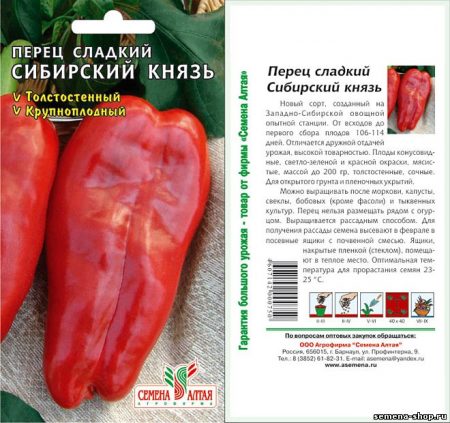
Pericarp - 5 mm, the taste of peppers is good, there is a pronounced aroma. Suitable for all types of processing, for the preparation of salads. In terms of productivity, its indicators are also not bad, you can collect up to 4.2-4.5 kg per square meter.
Grade for unpretentiousness and resistance to adverse weather conditions is appreciated.
Lumina
This variety is familiar even to those who are not involved in gardening matters, or rather, its fruits are familiar. The thing is that Lumina pepper appears on sale earlier than others in all regions of the Russian Federation.
Dense cones of white-greenish color reach a mass of about 100-120 grams. The taste is classic, pleasant, fruit walls in thickness - 4-5 mm. Variety value: stability and reliability during cultivation, which is especially important for gardeners in the northern regions. Even in the conditions of Siberia and the Urals, planting this variety can hope for good results.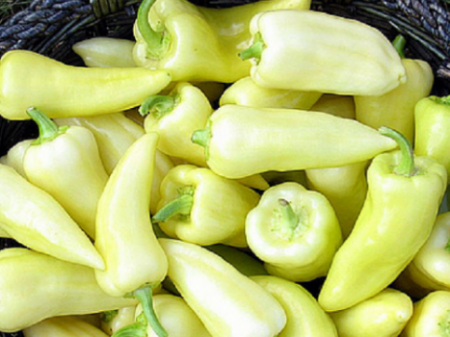
The early pepper has a medium height bush, does not require the formation of a plant. Unpretentious, with friendly return of fruits, a variety that is speedy and suitable for transportation.
Ivanhoe
The early “knightly” variety belongs to determinant plants, the fruits can be removed from the bush after 110 days. The bush is low, quite compact. The fruits are cone-shaped, and it is this shape that makes them suitable for stuffing.Many gardeners specifically plant several bushes of this variety precisely for obtaining thick-walled (up to 6-7 mm) fruits.
Peppers grow up to 140 grams in weight, bright red or orange in color. It is recommended to remove the first “wave” of fruits in a state of technical ripeness, which will enable the plant to form a subsequent batch of peppers.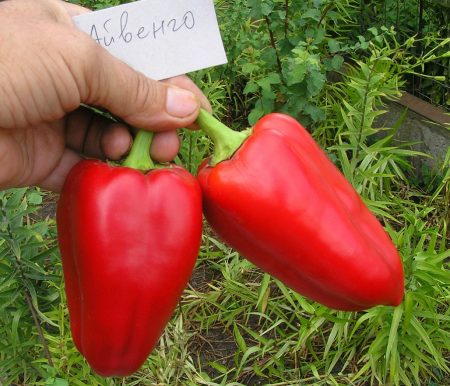
It is advisable to grow Aivengo in greenhouses, with good care, up to 8 kg of peppers are collected per square meter.
Marinkin tongue
Not quite early (up to 120 days), but on the other hand, a productive variety of pepper Marinkin tongue will surprise with original fruits. On bushes 60-70 cm high, elongated cones of pepper are formed, having thick walls. At the same time, the stalk of the pericarp is about 7-8 mm, in the rest of the fetus - up to 10-12 mm.
The fruits are tasty, fleshy, aromatic. When fully ripened, peppers have a pronounced red color.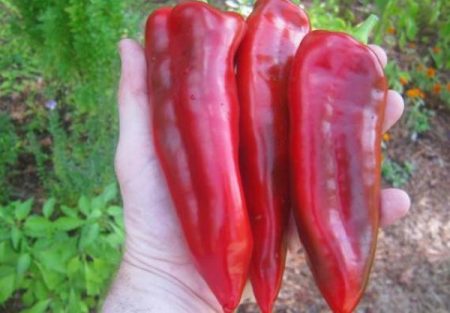
The variety was bred in Dnepropetrovsk, tolerates small temperature drops, does not reduce the number of ovaries and fruits under adverse weather conditions. Recommended for all climatic zones of the Russian Federation.
Peppers are suitable for transportation, but not long-term storage.
Triton
The unpretentious and productive variety Triton will thank delicious and large fruits for the care. He refutes the position that early peppers are inferior in taste to late varieties.
Triton's cone-shaped peppers grow to 130-150 grams, have a beautiful bright red color. The wall thickness is up to 5-6 mm, the pulp is very juicy.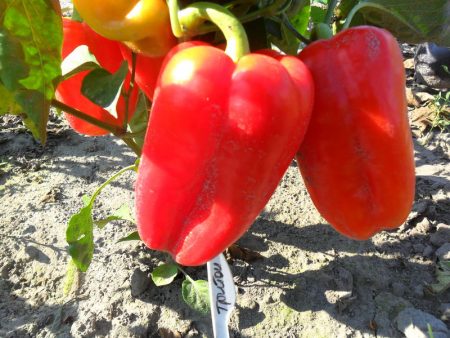
The plant is low, about 55 cm tall. The leaves grow with “umbrellas”, on the bush for the whole season up to 30 fruits. The variety is very productive, but requires nutrition and care. With proper agricultural technology, indicators of 10-11 kg of fruit from one "square" are quite achievable.
The variety has earned reviews from summer residents from various regions, but in the conditions of Siberia, the European North, and the Urals, it is recommended to cultivate Triton in greenhouses or hotbeds.
Atlant
Mid-early grade Atlant is quite consistent with the name. Its fruits are dense and large, usually reaching a mass of up to 250 grams.
The bush has a height of up to 70 cm, is distinguished by average foliage, compactness. The first cuboid peppers (still green, in a state of technical maturity) can be removed after about 110-115 days. The fruits are juicy, with fleshy and very tasty pulp. Pericarpium - 8-11 mm.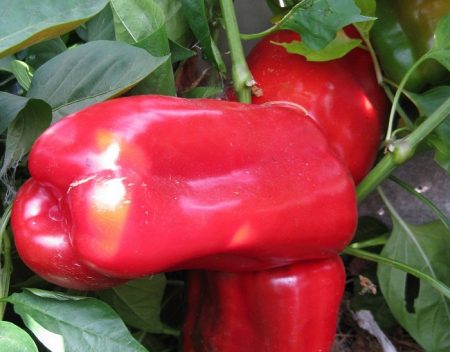
The value of the variety is not only in its productivity and thick-walled fruits, but also in resistance to many diseases. Today, breeders have bred the Atlant F1 hybrid, the fruits of which are larger in weight than the variety, and the growing season is slightly reduced.
the charm
Yes, this F1 hybrid will definitely “charm” everyone who decides to choose it for their greenhouse. Tasty and juicy fruits grow up to 100 grams in weight, and the total yield with good care will be up to 10-12 kg per square meter.
Compact Charm bushes grow up to 60-80 cm, fruits - cones, up to 12 cm long. Feature - thin-billed peppers, pericarp only 1,5-2 mm. The hybrid tolerates temperature fluctuations very well, gives an early harvest (after 110 days), is resistant to a number of diseases, including verticillosis.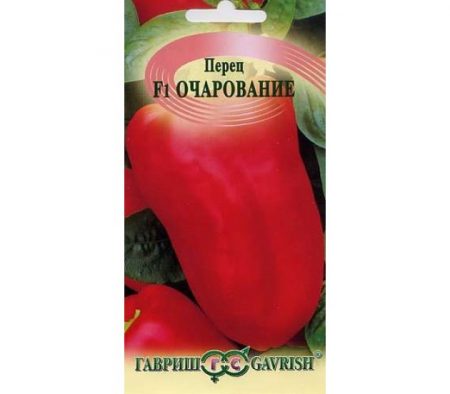
Fruits first have a yellowish-green color, then, when ripe, turn dark red.
Snow White
In the conditions of a short summer, the Snow White variety, belonging to the group of determinant peppers, proved to be not bad. On a small bush up to 50 cm tall, long cone-shaped peppers grow up, weighing up to 70-90 grams.The skin color is white, while there are no particular differences in pepper color in the period of technical and biological ripeness.
The pericarp of the fruits of Snow White reaches 6-7 mm, the flesh is very juicy and tender. The taste qualities of the fruits are excellent; it is no coincidence that this variety is preferred to be grown on farms. In yield - up to 6 kg of fruits per 1 m2, while the variety does not require any special care.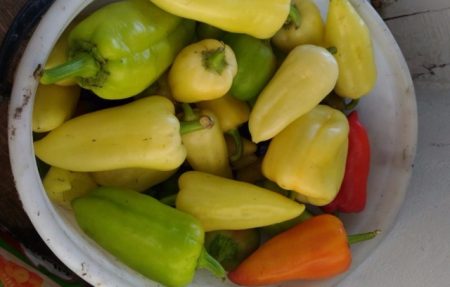
In the conditions of the cottage, Snow White produces excellent results in greenhouses and tunnels (film, non-woven material).
Early Pepper Growing Rules
The agricultural technology of pepper cultivation in the early stages of ripening does not differ from standard methods. The main thing here is to calculate the timing of sowing seeds, as cultures are grown through seedlings and a number of factors must be taken into account.
- Climatic conditions (weather, spring temperatures, warming air, soil, probability of frost return).
- The conditions in which pepper will be grown (greenhouse, special greenhouse, shelters on ridges).
- Features of the variety (bushes height, plant habit).
- The weather of a particular season.
The best age for early pepper seedlings is 60-70 days. Do not rush into crops, as overgrown peppers will not take root well, will slow down in their development.
It is recommended to grow pepper without picking. In this case, the seeds are sown immediately in small plates, and then, when these leaves appear in plants (2-3), transshipment is done in a larger container. For peppers, a 500 ml pot or glass will suffice.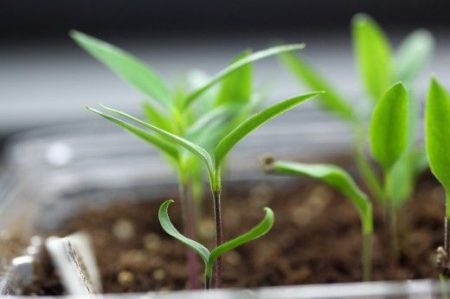
Another option is to sow seeds in peat tablets, and then plant them directly in tablets in prepared pots with soil.
Seedling: what are we paying attention to?
Peppers are considered plants that sprout for a long time. It is necessary to provide them with comfortable conditions: moisture, light, heat. After sowing, the seeds in the pots are cleaned in a dark place, withstanding temperatures up to + 25ºC ... + 28ºC. This will be enough for the peppers to begin to emerge, but the time it takes for the seedlings to germinate is difficult to determine. Sometimes peppers appear after 4-5 days, in other situations, sprouts wait up to 10-14 days.
As soon as the first shoots appear, the pots are exposed to light, while the temperature is reduced to + 18ºC. This will allow seedlings not to stretch, adapt and grow stronger. After 5-6 days, the temperature regime is changed again, increasing the degrees to indicators that are comfortable for pepper + 23ºC ... + 25ºC.
After about 14 days, the peppers can be fed using complex fertilizers.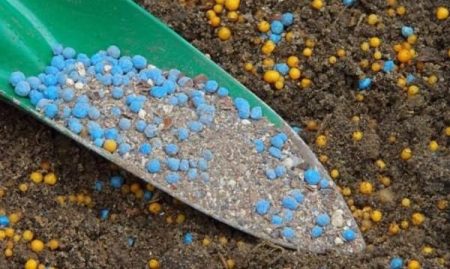
Seedlings are placed on window sills or shelves so that the plants do not touch each other, do not obscure. About 10-14 days before the planting of early peppers in the greenhouse, they must be accustomed to fresh air. What is being offered? Take bushes to the veranda (balcony or any other place), where it is possible to open windows, provide peppers with fresh air.
Planting peppers
Usually seedlings of early varieties have when planting about 8-9 leaves, a couple of buds.
Landing is carried out only with the establishment of stable warm temperatures. Indicator - the soil should be warmed up to + 14ºC ... + 16ºC. Peppers are usually planted closer to the end of May in the greenhouse, and not earlier than June 8-10 in tunnels and ridges. At the same time, it is advisable to cover the plants with non-woven material so that they better take root and grow.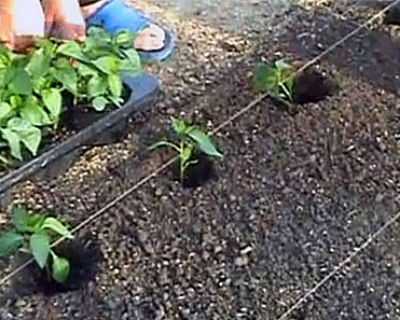
Early peppers usually have a small height, so it is allowed to plant up to 6-9 plants per square meter of ridge. You can plant such varieties and compacted plantings, adding to tall tomatoes (for example, in a greenhouse). But we must take into account not only the height of the bush, but also habitus (sprawling, leafy).
Crop care
Further care is normal and includes:
- regular top dressing;
- watering;
- loosening (if not mulching the soil).
Immediately after planting, peppers are not watered for about 5-6 days, allowing the development of the root system of plants. Then they are watered according to the weather (in open ground), and according to the state of plants and soil (in the greenhouse). Water is only warm, + 20ºC, always defended.
Watering with cold water can lead to the appearance of rot, various diseases of peppers.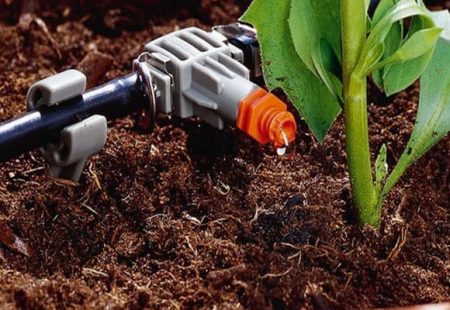
Top dressing begins to be carried out approximately 18-21 days after the planting of peppers, be sure to observe the rate of application of all nutrients. Organics are recommended to alternate with mineral additives, while fresh manure for peppers is not introduced.
At the first stage of the growing season they give nitrogen; during flowering and at the beginning of fruiting, peppers need potassium and phosphorus. Feeding with yeast formulations, ash infusions, as well as green “teas” (on nettles or other weeds) are effective.
Early low-growing peppers do not need to be formed, but if the bush is tall, it is better to remove the extra shoots. During the harvesting period, almost all peppers need support, so it is recommended to substitute pegs under the brushes and tie up the stems.
The fruits begin to collect in a state of technical ripeness of peppers. During this period, they still do not acquire the color characteristic of the variety (red, yellow, orange), but they have reached certain indicators in terms of weight and size. Early harvesting of the first fruits makes it possible to form the following peppers on the bush, which in the best way affects the overall yield.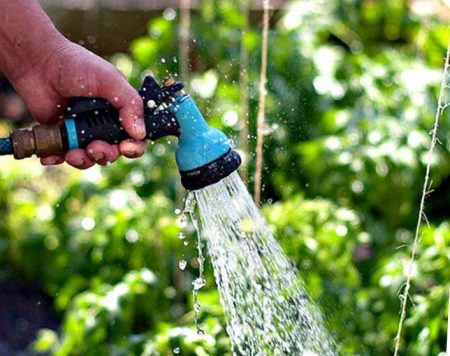
Peppers taken during the period of technical maturity ripen perfectly at home, and they can also be used in food and in green.
The selection and cultivation of early peppers allows gardeners of climatically difficult regions to get good harvests of tasty and healthy vegetables.
Reviews
Marina, Penza Region
Atlant pepper was grown; the seeds were from two different producers. Excellent fruits were born, and interestingly, they are very similar to each other. Pepper is beyond praise, although our summer was not very good in warmth. My peppers grow in a greenhouse, planted 5 plants per square meter. I fed three times, and so - only watering and that's it. Unpretentious variety and fruitful!
Stas, Kineshma
I always plant only early peppers, I do not recognize any tall late and other sophisticated varieties. I always grow Lumin, or it is also called Belozerka. Better than it, I think, there is no pepper, Tall people always need a lot of attention, and these are 50 cm in height, and I remove the first peppers from them at the end of June. And so to the frost. Leaving is minimal, return is maximum. No, you can, of course, other varieties, but for me it’s a waste of time.
Elizabeth, Yekaterinburg
I bought seeds of the Siberian prince variety, I read about it in one of the forums, it was very praised. It was developed for Siberia, and therefore decided to try it. Early pepper, the fruits were large, fleshy, very tasty. I didn’t have anything left to prepare, everything was left fresh. The son only ate him, and he doesn’t really like fresh peppers, here he just crunched. Now she planned to plant it again this year, and also Krepysh and Red Bull, also juicy and “meat” peppers.




 Calorie pepper stuffed with meat and rice - BZHU per 100 grams
Calorie pepper stuffed with meat and rice - BZHU per 100 grams Gorky pepper - the best varieties for open ground
Gorky pepper - the best varieties for open ground Hot pepper seeds - the best varieties for open ground and reviews
Hot pepper seeds - the best varieties for open ground and reviews Capsicum tincture for hair - how to use and reviews
Capsicum tincture for hair - how to use and reviews